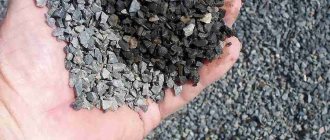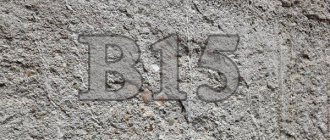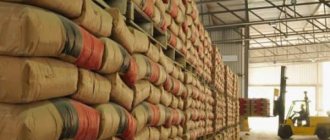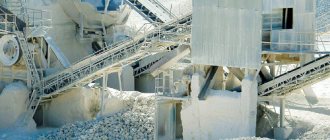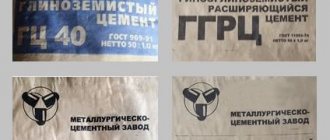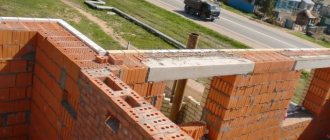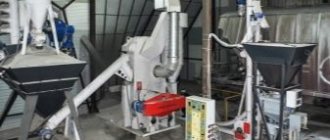5 Technical requirements
5.1 Mixtures must be manufactured in accordance with the requirements of this standard according to technological documentation approved in the prescribed manner by the manufacturer.
5.2 The grain compositions of the mineral part of mixtures and asphalt concretes must correspond to those indicated in the table.
Table 1
Percentage by weight
| Type of mixtures and asphalt concretes | Grain size, mm, finer | |||||||||
| 20 | 15 | 10 | 5 | 2,5 | 1,25 | 0,63 | 0,315 | 0,16 | 0,071 | |
| ShMA-10 | — | — | 100-90 | 40-30 | 29-19 | 26-16 | 22-13 | 20-11 | 17-10 | 15-10 |
| ShMA-15 | — | 100-90 | 60-40 | 35-25 | 28-18 | 25-15 | 22-12 | 20-10 | 16-9 | 14-9 |
| ShMA-20 | 100-90 | 70-50 | 42-25 | 30-20 | 25-15 | 24-13 | 21-11 | 19-9 | 15-8 | 13-8 |
Note - During acceptance tests, it is allowed to determine the grain composition of mixtures using control sieves in accordance with the data in bold.
5.3 Indicators of the physical and mechanical properties of asphalt concrete used in specific road and climatic zones must correspond to those indicated in the table.
table 2
| Indicator name | The value of the indicator for road climate zones | ||
| I | II, III | IV, V | |
| Porosity of the mineral part, % | From 15 to 19 | From 15 to 19 | From 15 to 19 |
| Residual porosity, % | From 1.5 to 4.0 | From 1.5 to 4.5 | From 2.0 to 4.5 |
| Water saturation, % by volume: | |||
| samples molded from mixtures | From 1.0 to 3.5 | From 1.0 to 4.0 | From 1.5 to 4.0 |
| cuttings and cores of the finished coating, no more | 3,0 | 3,5 | 4,0 |
| Compressive strength, MPa, not less than: | |||
| at a temperature of 20 °C | 2,0 | 2,2 | 2,5 |
| at a temperature of 50 °C | 0,60 | 0,65 | 0,70 |
| Shear resistance: | |||
| coefficient of internal friction, not less | 0,92 | 0,93 | 0,94 |
| shear adhesion at a temperature of 50 °C, MPa, not less | 0,16 | 0,18 | 0,20 |
| Crack resistance - tensile strength upon splitting at a temperature of 0 °C, MPa: | |||
| no less | 2,0 | 2,5 | 3,0 |
| no more | 5,5 | 6,0 | 6,5 |
| Water resistance during long-term water saturation, not less | 0,90 | 0,85 | 0,75 |
Notes
1 For ShchMA-10 it is allowed to reduce the norms of the internal friction coefficient by 0.01 in absolute value.
2 When using polymer-bitumen binders, it is allowed to reduce the norms of shear adhesion and tensile strength during splitting by 20%.
3 When using mixtures to cover airfields in aircraft parking areas, the standards for compressive strength and shear adhesion should be increased by 25%.
5.4 Mixtures must pass the test for adhesion of the binder to the surface of the mineral part of the mixture.
5.5 Mixtures must be resistant to delamination during transportation and loading and unloading. Resistance to delamination is determined in accordance with the application by the binder flow rate, which should be no more than 0.20% by weight. When selecting the composition of the mixture, it is recommended that the binder flow rate be in the range from 0.07% to 0.15% by weight.
5.6 Mixtures must be homogeneous. The homogeneity of mixtures is assessed by the coefficient of variation of compressive strength indicators at a temperature of 50 °C, which should be no more than 0.18.
5.7 The temperature of the mixtures, depending on the bitumen binder used, during shipment to the consumer and during installation, must correspond to the values indicated in the table.
Table 3
| Needle penetration depth, 0.1 mm, at 25 °C | Temperature, °C | |
| upon shipment | when laying, no less | |
| From 40 to 60 incl. | From 160 to 175 | 150 |
| Over 60 to 90 incl. | From 155 to 170 | 145 |
| St. 90 to 130 incl. | From 150 to 165 | 140 |
| St. 130 to 200 | From 140 to 160 | 135 |
5.8 Mixtures and asphalt concrete, depending on the value of the total specific effective activity of natural radionuclides (Aeff) in the materials used [], are used for:
Aeff up to 740 Bq/kg - for the construction of roads and airfields without restrictions;
Aeff up to 1500 Bq/kg - for the construction of roads outside populated areas and areas of promising development.
5.9 It is recommended to design the compositions of mixtures and asphalt concrete in accordance with the appendix. The compositions of mixtures for the installation of top layers of surfaces for airfield runways must be approved in accordance with the established procedure with the Aeroproekt Institute.
5.10 Material requirements
5.10.1 Crushed stone from dense rocks and crushed stone from metallurgical slag included in the mixtures must comply with the requirements of GOST 8267 and GOST 3344. For the preparation of mixtures and asphalt concrete, crushed stone of a fraction from 5 mm to 10 mm is used, st. 10 mm to 15 mm, St. 15 mm to 20 mm, as well as mixtures of fractions from 5 mm to 15 mm and from 5 mm to 20 mm. The crushability grade of crushed stone from igneous and metamorphic rocks must be at least 1200, from sedimentary rocks, gravel and metallurgical slag - at least 1000, the abrasion grade of crushed stone must be I1. The frost resistance grade of crushed stone must be at least F50.
The content of lamellar (flaky) and needle-shaped grains in crushed stone should be no more than 15% by weight.
The content of crushed grains in the crushed gravel used must be at least 85% by weight.
5.10.2 Sand from rock crushing screenings must comply with the requirements of GOST 8736; The sand strength grade must be at least 1000; the content of clay particles determined by the swelling method is no more than 0.5%, while the content of grains finer than 0.16 mm (including dust and clay particles in this fraction) is not standardized.
5.10.3 Mineral powder must comply with the requirements of GOST 16557*. With an appropriate feasibility study, it is allowed to use dust from the dust collection system of the mixing plant instead of mineral powder in such a quantity that its content in grains finer than 0.071 mm is no more than 50% by weight. The content of clay particles in collection dust, determined by the swelling method, should be no more than 5.0% by weight.
___________
* GOST R 52129-2003 is in force on the territory of the Russian Federation.
(Amendment, IUS 8-2004).
5.10.4 Cellulose fiber or special granules based on it are used as a stabilizing additive, which must comply with the requirements of the technical documentation of the manufacturer.
Cellulose fiber must have a ribbon structure of threads with a length of 0.1 mm to 2.0 mm. The fiber must be homogeneous and free from tufts, accumulations of uncrushed material and foreign inclusions. In terms of physical and mechanical properties, cellulose fiber must correspond to the values indicated in the table.
Table 4
| Indicator name | Indicator value |
| Humidity, % by mass, no more | 8,0 |
| Heat resistance at a temperature of 220 °C based on weight change during heating, %, no more | 7,0 |
| Content of fibers with a length from 0.1 mm to 2.0 mm, %, not less | 80 |
It is allowed to use other stabilizing additives, including polymer or other fibers with a round or elongated cross-section of threads with a length of 0.1 mm to 10.0 mm, capable of sorbing (holding) bitumen at process temperatures without having a negative effect on the binder and mixtures. The justification for the suitability of stabilizing additives and their optimal content in the mixture is established by testing ShchMA in accordance with GOST 12801 and the resistance to delamination of the mixture in accordance with the appendix.
5.10.5 As binders, viscous petroleum road bitumen is used in accordance with GOST 22245, as well as modified polymer-bitumen binders (PBB) and other bitumen binders with improved properties in accordance with regulatory and technical documentation agreed upon and approved by the customer in the prescribed manner.
List of normative documents, references to which are used in this standard
GOST 3344-83 Crushed stone and slag sand for road construction. Specifications
GOST 8267-93 Crushed stone and gravel from dense rocks for construction work. Specifications
GOST 8269.0-97 Crushed stone and gravel from dense rocks and industrial waste for construction work. Methods of physical and mechanical tests
GOST 8735-88 Sand for construction work. Test methods
GOST 8736-93 Sand for construction work. Specifications
GOST 11501-78 Petroleum bitumens. Method for determining needle penetration depth
GOST 11505-75 Petroleum bitumens. Method for determining elongation
GOST 11506-73 Petroleum bitumens. Method for determining the softening temperature by ring and ball
GOST 11507-78 Petroleum bitumens. Fraas brittleness temperature method
GOST 12784-78* Mineral powder for asphalt concrete mixtures. Test methods
GOST 12801-98 Materials based on organic binders for road and airfield construction. Test methods
GOST 16557-78* Mineral powder for asphalt concrete mixtures. Specifications
GOST 22245-90 Viscous petroleum road bitumens. Specifications
GOST 23932-90 Laboratory glassware and equipment. General technical conditions
GOST 24104-2001 Laboratory scales. General technical requirements
GOST 30108-94 Construction materials and products. Determination of specific effective activity of natural radionuclides
___________
* GOST R 52129-2003 is in force on the territory of the Russian Federation. Mineral powder for asphalt concrete and organomineral mixtures. Technical conditions.
(Amendment, IUS 8-2004).
7 Control methods
7.1 Crushed stone-mastic mixtures and asphalt concrete are tested according to GOST 12801.
7.2 The binder flow rate is determined according to Appendix B of this standard.
7.3 Asphalt concrete samples are made in standard cylindrical molds with a diameter of 71.4 mm, compacted by vibration followed by additional compaction by pressing. The temperature of the mixture when preparing samples should correspond to Table 3.
7.4 Sand from rock crushing screenings is tested according to GOST 8735; crushed stone according to GOST 8269.0; petroleum road viscous bitumens and polymer-bitumen binders in accordance with GOST 11501, GOST 11505, GOST 11506, GOST 11507 and current regulatory and technical documentation; mineral powder according to GOST 12784*.
____________________
* GOST R 52129-2003 is in force on the territory of the Russian Federation.
7.5 The content of natural radionuclides in the materials used is determined according to GOST 30108.
7.6 The moisture content and heat resistance of the fiber are determined according to Appendix D of this standard.
Recommendations for the design of crushed stone-mastic asphalt concrete
B.1 Crushed stone-mastic asphalt concrete ShMA-10
Table B.1 - Requirement for materials for preparing the mixture
| Material | Material requirement,% by weight |
| Crushed stone fractions, mm: | |
| 5-10 | 60-70 |
| 10-15 | — |
| 15-20 | — |
| Sand from crushing screenings | 10-30 |
| Mineral powder | 10-20 |
| Bitumen or PBB | 6,5-7,5 |
| Stabilizing additive | 0,2-0,5 |
Table B.2 - Used bitumen binders
| Road climate zone | I | II-III | IV-V |
| Needle penetration depth, 0.1 mm, at 25 °C | 90-200 | 60-130 | 40-90 |
Note - More viscous bitumen and PMB are recommended for use on roads with higher traffic volumes.
Table B.3 - Grain composition of the mineral part of ShchMA-10
| Content of mineral grains, %, finer than a given size, mm | |||||||||
| 20 | 15 | 10 | 5 | 2,5 | 1,25 | 0,63 | 0,315 | 0,16 | 0,071 |
| 100 | 100 | 90-100 | 30-40 | 19-29 | 16-26 | 13-22 | 11-20 | 10-17 | 10-15 |
Figure B.1
— Grain composition of the mineral part of ShchMA-10
Table B.4 - Construction of top layers of road surfaces made of ShchMA-10
| Recommended layer thickness, cm | Mixture consumption, kg/m2 |
| 2,0-4,0 | 50-100 |
B.2 Crushed stone-mastic asphalt concrete ShMA-15
Table B.5 - Requirement for materials for preparing the mixture
| Material | Material requirement,% by weight |
| Crushed stone fractions, mm: | |
| 5-10 | 15-25 |
| 10-15 | 40-60 |
| 15-20 | — |
| Sand from crushing screenings | 5-20 |
| Mineral powder | 10-20 |
| Bitumen or PBB | 6,0-7,0 |
| Stabilizing additive | 0,2-0,5 |
Table B.6 - Used bitumen binders
| Road climate zone | I | II-III | IV-V |
| Needle penetration depth, 0.1 mm, at 25 °C | 90-200 | 60-130 | 40-90 |
Note - More viscous bitumen and PMB are recommended for use on roads with higher traffic volumes.
Table B.7 - Grain composition of the mineral part of ShchMA-15
| Content of mineral grains, %, finer than a given size, mm | |||||||||
| 20 | 15 | 10 | 5 | 2,5 | 1,25 | 0,63 | 0,315 | 0,16 | 0,071 |
| 100 | 90-100 | 40-60 | 25-35 | 18-28 | 15-25 | 12-22 | 10-20 | 9-16 | 9-14 |
Figure B.2
— Grain composition of the mineral part of ShchMA-15
Table B.8 - Construction of top layers of road surfaces made of ShchMA-15
| Recommended layer thickness, cm | Mixture consumption, kg/m2 |
| 3,0-5,0 | 75-125 |
B.3 Crushed stone-mastic asphalt concrete ShMA-20
Table B.9 - Requirement for materials for preparing the mixture
| Material | Material requirement,% by weight |
| Crushed stone fractions, mm: | |
| 5-10 | 10-15 |
| 10-15 | 20-30 |
| 15-20 | 30-50 |
| Sand from crushing screenings | 5-15 |
| Mineral powder | 10-20 |
| Bitumen or PBB | 5,5-6,0 |
| Stabilizing additive | 0,2-0,5 |
Table B.10 - Used bitumen binders
| Road climate zone | I | II-III | IV-V |
| Needle penetration depth, 0.1 mm, at 25 °C | 90-200 | 60-130 | 40-90 |
Note - More viscous bitumen and PMB are recommended for use on roads with higher traffic volumes.
Table B.11 - Grain composition of the mineral part of ShchMA-20
| Content of mineral grains, %, finer than a given size, mm | |||||||||
| 20 | 15 | 10 | 5 | 2,5 | 1,25 | 0,63 | 0,315 | 0,16 | 0,071 |
| 90-100 | 50-70 | 25-42 | 20-30 | 15-25 | 13-24 | 11-21 | 9-19 | 8-15 | 8-13 |
Figure B.3
— Grain composition of the mineral part of ShchMA-20
Table B.12 - Construction of top layers of road surfaces made of ShchMA-20
| Recommended layer thickness, cm | Mixture consumption, kg/m2 |
| 4,0-6,0 | 100-150 |
3 Definitions
For the purposes of this standard, the following terms and corresponding definitions apply.
Crushed stone-mastic asphalt concrete mixture (SCMAS)
- a rationally selected mixture of mineral materials (crushed stone, sand from crushing screenings and mineral powder), road bitumen (with or without polymer or other additives) and a stabilizing additive, taken in certain proportions and mixed in a heated state.
Crushed stone mastic asphalt concrete (SMA)
— compacted crushed stone-mastic asphalt concrete mixture.
Stabilizing additive
- a substance that has a stabilizing effect on SMAS and ensures its resistance to delamination.
Method for determining the resistance of a mixture to delamination based on the binder flow rate
The essence of the method is to assess the ability of a hot crushed stone-mastic asphalt concrete mixture to retain the binder contained in it.
B.1
Control means and auxiliary equipment
Laboratory scales of the 4th accuracy class according to GOST 24104.
Heat-resistant chemical glasses according to GOST 23932 with a capacity of 1000 cm3 and a diameter of 10 cm.
Cover glasses.
Chemical mercury glass thermometer with a measurement range from 100 °C to 200 °C with a scale division of no more than 1 °C.
Drying cabinet.
B.2
Procedure for preparing for testing
The prepared crushed stone-mastic asphalt concrete mixture is heated to the maximum temperature in accordance with the table and mixed thoroughly. The drying cabinet is also heated to the specified temperature, which is maintained during the test period with a permissible error of ±2 °C.
The empty glass is weighed, placed in a drying cabinet and kept at the temperature indicated in the table for at least 10 minutes. Then the glass is placed on a scale and 0.9-1.2 kg of the mixture is quickly placed in it, weighed and covered with a cover glass.
B.3
Test procedure
The glass with the mixture is placed in a drying cabinet, where it is kept at the maximum temperature indicated in the table for (60 ± 1) minutes. Then the glass is removed, the cover glass is removed from it and the mixture is removed by turning the glass over without shaking upside down for (10 ± 1) s. After this, the glass is placed on the bottom again, cooled for 10 minutes and weighed along with the remains of the binder and the mixture adhering to its inner surface.
B.4 Processing of test results
Binder flow B
,% by weight, determined by the formula
, (IN 1)
where g1, g2, g3 are the mass of the glass, respectively, empty, with the mixture and after its removal, g.
The arithmetic mean value of two parallel determinations rounded to the second decimal place is taken as the test result. The discrepancy between the results of parallel tests should not exceed 0.05% in absolute value. In case of large discrepancies, the runoff of the binder is determined again and the data of four determinations are taken to calculate the arithmetic mean.
4 Basic parameters and types
Crushed stone-mastic asphalt concrete mixtures (hereinafter referred to as mixtures) and crushed stone-mastic asphalt concrete (hereinafter referred to as asphalt concrete), depending on the size of the crushed stone used, are divided into types:
| ShMA-20 | — | With | the largest | size | grains | before | 20 mm; | ||
| ShMA-15 | — | » | » | » | » | » | 15 mm; | ||
| ShMA-10 | — | » | » | » | » | » | 10 mm. | ||
Determination of moisture content and heat resistance of fibers
The essence of the method is to determine the loss of fiber mass at a given temperature and test time.
D.1 Controls and auxiliary equipment
Rectangular metal baking trays measuring 20 ´ 10 ´ 2 cm.
Drying cabinet with a thermostat that maintains the temperature with an accuracy of ±3 °C.
Glass mercury thermometer with scale division of 1 °C.
Desiccator according to GOST 23932 with anhydrous calcium chloride.
Laboratory scales according to GOST 24104, 4th accuracy class.
D.2 Preparation for testing
Before testing, a fiber sample is placed on a sheet of paper and loosened by hand, eliminating lumps if there are any in the sample.
Thoroughly washed metal trays are placed in a drying oven at a temperature of (105 ± 3) °C for at least 30 minutes, then cooled in a desiccator to room temperature.
D.3 Test performance
When testing fibers, weighing is carried out with a permissible weighing error of 0.1% by weight. Mass is determined in grams accurate to the second decimal place.
The test is carried out in two baking trays. Each baking sheet prepared according to G.2 is weighed. From the fiber sample prepared according to G.2, take two portions of (5 ± 1) g each and pour them into baking trays, filling them evenly without compaction. The trays containing the fiber are weighed and placed in a drying oven at a temperature of (105 ± 3) °C to dry the fibers.
After 30 minutes, the trays containing the fibers are removed from the oven, placed in a desiccator, cooled to room temperature, weighed and placed back in the desiccator.
Trays with fibers dried in an oven at a temperature of (105 ± 3) °C and cooled in a desiccator to room temperature are placed in an oven preheated to (220 ± 3) °C.
The temperature is controlled with a thermometer, the mercury reservoir of which is located at the height of the baking trays.
Since when cold baking sheets are installed, the temperature of the drying cabinet decreases, the time the baking sheets with fibers remain in the drying cabinet is counted from the moment the set temperature is reached.
The trays with fibers are kept in a drying oven at a temperature of (220 ± 3) °C for 5 minutes.
After the holding time has elapsed, the trays with fibers are removed from the drying oven, placed in a desiccator, cooled to room temperature and weighed.
D.4 Processing of results
Fiber moisture W
, %, determined by the formula
, (D.1)
where g
1 - weight of the baking sheet, g;
g
2 - weight of the baking sheet with fibers, g;
g
3- weight of the baking sheet with fibers after drying in an oven, g.
Thermal resistance of fibers T
in, %, determined by the formula
, (D.2)
where g4 is the weight of the baking sheet with fibers after keeping in an oven at a temperature of (220 ± 3) °C, g.
The discrepancy between the results of two parallel determinations should not be more than 0.5% (in absolute value). The arithmetic mean of the results of two parallel determinations, rounded to the first decimal place, is taken as the result.

